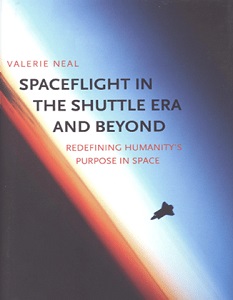Which is better – spaceflight with a crew, or without? It’s been the subject of a heated debate among the space community for decades and seems likely to continue for decades to come. This book provides ammunition to the debate by considering the place of the Space Shuttle in the broader history of spaceflight. Subtitled ‘Redefining Humanity’s Purpose in Space’, it is written by the Chair of the history department at the Smithsonian National Air and Space Museum, who is better-placed to comment than most.
As the author reminds us, the Shuttle was (often at the same time) “billed as delivery truck and orbiting science lab, near-Earth station and space explorer, costly disaster and pinnacle of engineering success”. The book’s multidisciplinary approach reveals these competing depictions to “unpack the meaning of the spaceflight enterprise”. It is replete with the trappings of an academic history (50-plus pages of chapter notes and index) and, at the same time, extremely readable – no mean feat in itself! It is illustrated in black-and-white with a small colour insert.
Published six years after the final Shuttle mission in a 30-year-long programme, the book is a timely reminder of the state of play in American crewed spaceflight and the apparent lack of urgency to replace the Shuttle with anything even mildly comparable. The author puts her finger on the reason for this in her introduction: “No single concept has become the foundation for a lasting consensus about why humans should or should not be sent into space”. She points out that although the image of space as a frontier appeals to those who “came of age in the mid-1900s”, it does not resonate with “younger generations… whose entertainment choices are fantasy computer games”. As a result, she suggests that it’s time for a “radical new paradigm – a millennial imaginary – that appeals to the values and traditions of twenty-first-century generations”.
As a museum employee, the author is well in tune with the bitter-sweet concept of ‘Space Shuttle as museum exhibit’ and those who have seen one on display will sympathise. Visitors experience at close quarters what are essentially flight-worthy spacecraft that have been continually upgraded and well-maintained, but are deemed ‘unaffordable’ or ‘surplus to requirements’.
Her thoughtful analysis of the four museum displays is both academic and advertorial: from a basic standpoint of displaying a “magnificent flying machine”, she says, “the four institutions departed on their own courses – one toward engineering innovation [displaying Enterprise in New York] one toward science learning [Endeavour in California], another toward emotion and personal experience [Atlantis in Florida], and the Smithsonian [Discovery] toward a measured historical assessment leavened with scholarly judgement”. None told the whole story, she adds, but “a visit to all four would yield a thoughtful understanding of the technology, its uses and its place in history”.
The operational life of, arguably, the most iconic manned spacecraft in history is over, but the debate on the role of humans in space has many years left to run. This book provides a good starting point for discussion of the post-Shuttle era.











